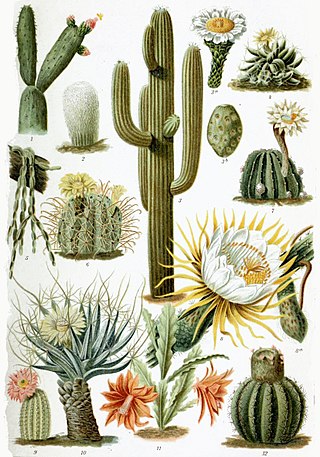
A cactus is a member of the plant family Cactaceae, a family of the order Caryophyllales comprising about 127 genera with some 1,750 known species. The word cactus derives, through Latin, from the Ancient Greek word κάκτος (káktos), a name originally used by Theophrastus for a spiny plant whose identity is now not certain. Cacti occur in a wide range of shapes and sizes. They are native to the Americas, ranging from Patagonia in the south to parts of western Canada in the north, with the exception of Rhipsalis baccifera, which is also found in Africa and Sri Lanka. Cacti are adapted to live in very dry environments, including the Atacama Desert, one of the driest places on Earth. Because of this, cacti show many adaptations to conserve water. For example, almost all cacti are succulents, meaning they have thickened, fleshy parts adapted to store water. Unlike many other succulents, the stem is the only part of most cacti where this vital process takes place. Most species of cacti have lost true leaves, retaining only spines, which are highly modified leaves. As well as defending against herbivores, spines help prevent water loss by reducing air flow close to the cactus and providing some shade. In the absence of true leaves, cacti's enlarged stems carry out photosynthesis.

Acanthocalycium is a genus of cactus consisting of several species from Argentina, Bolivia, Brazil, Paraguay and Uruguay. The taxon name comes from Greek akantha and kalyx, which refers to the spines on the floral tubes.

Echinopsis is a genus of cacti native to South America, sometimes known as hedgehog cactus, sea-urchin cactus or Easter lily cactus. As of October 2023, there are about 20 accepted species, ranging from large and treelike types to small globose cacti. The name derives from echinos hedgehog or sea urchin, and opsis appearance, a reference to these plants' dense coverings of spines.

Gymnocalycium, commonly called chin cactus, is a genus of about 70 South American species of cactus. The genus name Gymnocalycium refers to the flower buds bearing no hair or spines.
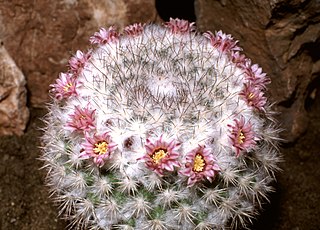
Mammillaria is one of the largest genera in the cactus family (Cactaceae), with currently 200 known species and varieties recognized. Most of the mammillarias are native to Mexico, while some come from the Southwestern United States, the Caribbean, Colombia, Guatemala, Honduras and Venezuela. The common name "pincushion cactus" refers to this genus and the closely-related Escobaria.

Cleistocactus is a genus of flowering plants in the cactus family Cactaceae, native to mountainous areas - to 3,000 m (9,843 ft) - of South America. The name comes from the Greek kleistos meaning closed because the flowers hardly open.

Parodia is a genus of flowering plants in the family Cactaceae, native to the eastern slopes of the Andes in northwestern Argentina and southwestern Bolivia and in the lowland pampas regions of northeastern Argentina, southern Brazil, eastern Paraguay, and Uruguay. This genus has about 65 species, many of which have been transferred from Eriocactus, Notocactus and Wigginsia. They range from small globose plants to 1 m (3 ft) tall columnar cacti. All are deeply ribbed and spiny, with single flowers at or near the crown. Some species produce offsets at the base. They are popular in cultivation, but must be grown indoors where temperatures fall below 10 °C (50 °F).

Discocactus is a genus of tropical cacti. Discocactus plants are endemic to southern Brazil, eastern Bolivia, and northern Paraguay. These species are in the risk of extinction in the wild.
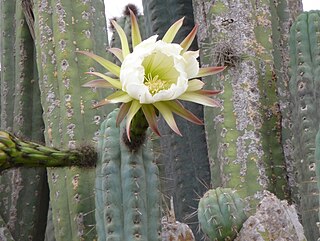
Echinopsis lageniformis, synonyms including Echinopsis scopulicola and Trichocereus bridgesii, is a cactus native to Bolivia. It is known as the Bolivian torch cactus. Among the indigenous populations of Bolivia, it is sometimes called achuma or wachuma, although these names are also applied to related species such as Trichocereus macrogonus which are also used for their psychedelic effects.

Soehrensia spachiana, commonly known as the golden torch, (white) torch cactus or golden column, is a species of cactus native to South America. Previously known as Trichocereus spachianus for many years, it is commonly cultivated as a pot or rockery plant worldwide. It has a columnar habit, with a lime-green cylindrical body with 1–2 cm long golden spines.

Echinocereus reichenbachii is a perennial plant and shrub in the cactus family. The species is native to the Chihuahuan Desert and parts of northern Mexico and the southern United States, where they grow at elevations up to 1,500 meters (4,900 ft). This cactus earned the Royal Horticultural Society's Award of Garden Merit.
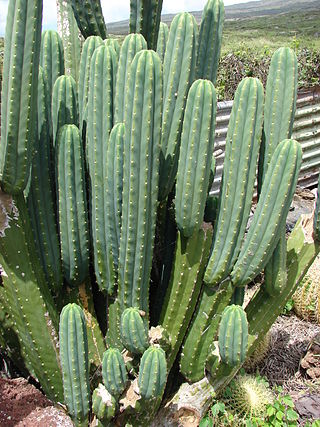
Trichocereus macrogonus var. pachanoi is a fast-growing columnar cactus found in the Andes at 2,000–3,000 m (6,600–9,800 ft) in altitude. It is one of a number of kinds of cacti known as San Pedro cactus. It is native to Ecuador, Peru and Colombia, but also found in Argentina, Bolivia, Chile and Venezuela and cultivated in other parts of the world. Uses for it include traditional medicine and traditional veterinary medicine, and it is widely grown as an ornamental cactus. It has been used for healing and religious divination in the Andes Mountains region for over 3,000 years.
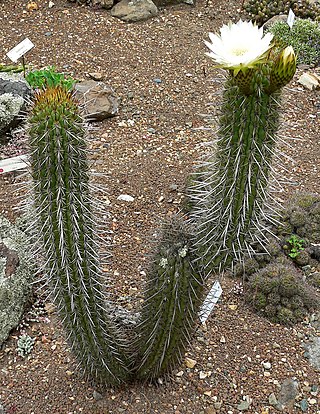
Leucostele chiloensis is a species of cactus native to South America; genus members are known as hedgehog cacti, sea-urchin cactus or Easter lily cactus.

Chamaecereus silvestrii is a species of cactus from northwestern Argentina and Bolivia. Synonyms include Echinopsis chamaecereus and Lobivia silvestrii. It has been called the peanut cactus. This plant should not be confused with Echinopsis silvestrii, a synonym of Echinopsis albispinosa, a species with a very different appearance.
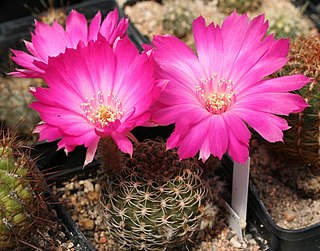
Lobivia backebergii is a species of flowering plant in the cactus family Cactaceae, native to eastern Bolivia and southern Peru.

Leucostele terscheckii, commonly known as the cardon grande cactus or Argentine saguaro, is a large cactus native to South America and popular in cultivation.

Gymnocalycium baldianum, the spider-cactus or dwarf chin cactus, is a species of flowering plant in the cactus family Cactaceae, native to the Catamarca Province in Argentina.

Oreocereus trollii, commonly known as the Old Man of the Andes cactus, is a species of cacti native to Argentina and Bolivia. Though listed as Least Concern by the IUCN, the plant is collected extensively, and in some areas is threatened.

Lobivia ancistrophora is a species of cactus. It has a globular shape, few spines, with large, white flowers attached to long, green tubes. It occurs in Bolivia, at altitudes of 600–1800 metres. Under its synonym Echinopsis ancistrophora it has gained the Royal Horticultural Society's Award of Garden Merit.
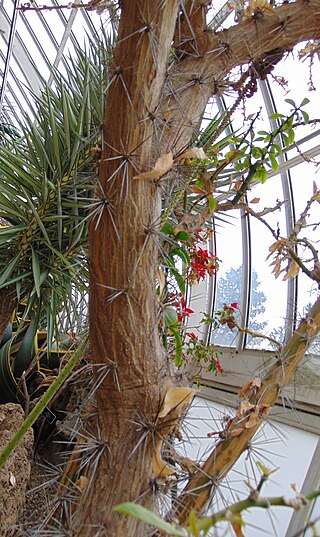
Rhodocactus nemorosus is a species of flowering plant in the cactus family Cactaceae, native to southern Brazil, Paraguay, Uruguay and northeast Argentina. Like all species in the genus Rhodocactus and unlike most cacti, it has persistent leaves. It was first described by Nicolás Rojas Acosta in 1897 as Pereskia nemorosa, and transferred to Rhodocactus in 2016.


























